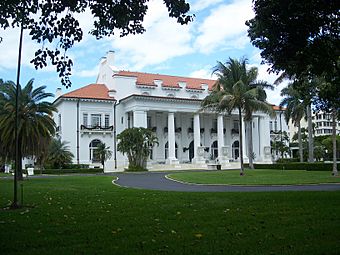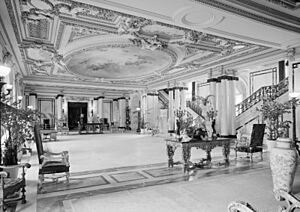Whitehall (Henry M. Flagler House) facts for kids
|
Whitehall (Henry M. Flagler House)
|
|

Henry M. Flagler Mansion
|
|
| Location | Palm Beach, Florida, USA |
|---|---|
| Built | 1900–1901 |
| Architect | Pottier & Stymus, Carrère and Hastings |
| Architectural style | Beaux Arts |
| NRHP reference No. | 72000345 |
Quick facts for kids Significant dates |
|
| Added to NRHP | December 5, 1972 |
| Designated NHL | February 16, 2000 |
Whitehall is a huge, fancy mansion in Palm Beach, Florida, USA. It has 75 rooms and is about 60,000 square feet (5575 square meters) in size. This amazing building was finished in 1902.
It's a great example of a style called Beaux Arts architecture. Famous architects Carrère and Hastings designed it for Henry Flagler. He was a very important businessman in the late 1800s. Flagler also helped develop Florida into a popular place for tourists.
Whitehall is now a special place called a National Historic Landmark. It is open to the public as the Henry Morrison Flagler Museum. The museum is named after the man who built this incredible home.
Contents
The Story of Whitehall
Henry Flagler was one of the people who started the famous company, Standard Oil. He built Whitehall as a wedding gift for his third wife, Mary Lily Kenan.
Flagler bought the land for Whitehall in 1893 for $50,000. That would be a lot more money today! Construction started in July 1900. Flagler and his wife moved into their new home on February 6, 1902.
The architects, John Carrère and Thomas Hastings, had designed other buildings for Flagler. Whitehall was meant to be their winter home. Each year, they would travel to Palm Beach in their own private train car, called No. 91.
Henry Flagler passed away in 1913 at age 83. He was injured after falling down some stairs at Whitehall. Mary Lily died four years later. The home then went to her niece, Louise Clisby Wise Lewis. She sold the property to some investors.
These investors added a large, ten-story hotel section to the building in 1925. This changed some of the original rooms, like Mr. Flagler's offices and the kitchen.
Visiting the Museum
In 1959, Whitehall was almost torn down. But one of Henry Flagler's granddaughters, Jean Flagler Matthews, saved it. She started a non-profit group called the Henry Morrison Flagler Museum. This group bought the building in 1959. It opened as a museum in 1960.
The top ten stories of the hotel addition were removed in 1963. This helped bring the building back closer to its original look.
Today, Whitehall is a National Historic Landmark. It is open to everyone as the Henry Morrison Flagler Museum. You can take guided tours, see exhibits, and enjoy special programs. Many programs happen from October to January.
The museum also has a yearly music series. It hosts the Whitehall lecture series, where experts talk about topics from the Gilded Age. This was a time of great wealth and change in American history. Past talks have covered presidents, engineering, and art from that era.
The Flagler Museum also puts on a special exhibition every year. These shows often feature Gilded Age paintings, sculptures, or cool items. You might see old board games, jewelry, or fancy silver pieces. The museum also hosts many local events throughout the year. You can find the museum at Cocoanut Row and Whitehall Way in Palm Beach.
The Mansion's Design
When Whitehall was finished in 1902, people were amazed. The New York Herald newspaper said it was "more wonderful than any palace in Europe." It was designed in the Beaux Arts style. This style was meant to compete with the grand mansions in Newport, Rhode Island.
Unlike those northern homes, Whitehall did not have many separate buildings. It also didn't have fancy, planned gardens. Plants, flowers, and trees were allowed to grow more naturally.
The mansion is built around a large open-air courtyard. Its design was inspired by palaces in Spain and Italy. Whitehall has three stories and several wings. Fifty-five of its rooms have been fully restored. They are filled with furniture from that time period. These rooms are very large. They have marble floors, walls, and columns. The ceilings have beautiful paintings, and there is a lot of gold decoration.
Flagler Kenan Pavilion
The Flagler Kenan Pavilion opened on February 4, 2005. It was the first new part added to the property since 1925. This 8,100 square foot (752 square meter) building cost $4.5 million. It is named after Henry Flagler and William R. Kenan Jr.. Kenan was Flagler's engineer, friend, and brother-in-law.
The pavilion was designed in the Beaux-Arts style. It took almost four years to build. The main attraction in this pavilion is Railcar No. 91. This was Flagler's private train car, built in 1886. The museum carefully restored the car using old documents and records. The pavilion also has a seasonal cafe where you can enjoy tea.
More to Explore
- Largest Historic Homes in the United States
- List of Gilded Age mansions
- List of National Historic Landmarks in Florida
See also
 In Spanish: Whitehall (mansión) para niños
In Spanish: Whitehall (mansión) para niños





